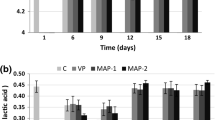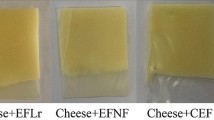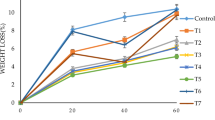Abstract
A comparative efficiency evaluation of PET waste-based packaging films is executed by shelf life appraisal of white fresh cheese. Thin film of PET was drawn from single-screw extruder by blending of vPET and rPET. Mechanical, rheological, and morphological properties of extruded PET film were found suitable to use it as packaging material. Furthermore, the PET film was immobilized, then activated to incorporate antimicrobial potential using three various concentrations of AgNPs, and projected to use as packaging material for white fresh cheese. The cheese samples were packaged into pouches made from active PET film, and were stored at 6, 25, and 40 °C for up to 30 days. Pre-packaging and post-packaging characteristics of fresh white cheese were carried out. Microbial, physicochemical, and sensory analyses of white fresh cheese packaged into PET film at various storage temperatures were carried out for up to 30 days. Results showed that the cheese samples packaged into active PET film observed no growth of microorganisms, whereas other samples observed progressive growth of microorganism. Results also indicated that 5% Ag–Cs–PET90:10 film is efficient enough to make cheese bacteria free within 7 days at 40 °C, whereas, for the same packaging duration and temperature, cheese packaged in an inactive PET film was found to be contaminated with 4.67 ± 0.05 log cfu/g of total mesophilic aerobic bacteria. The degree of activity of PET film found to be a function of storage duration, storage temperature, and concentration of AgNPs. Consequently, the PET waste-based active packaging film is found to be capable for shelf life extension of white fresh cheese up to 30 days.
Graphical abstract















Similar content being viewed by others
Notes
Intrinsic viscosity measured by ASTM D4603 using 60:40 of phenol and 1,1,2,2-tetrachloroethane.
The ratio of the proportional decrease in a lateral measurement to the proportional increase in length in a sample.
Stress required to obtain 5% elongation is said to be F-5 value.
Abbreviations
- PET:
-
Poly(ethylene terephthalate)
- vPET:
-
Virgin PET
- rPET:
-
Recycled PET
- PET90:10 :
-
vPET and rPET in 90:10 ratio
- AgNPs:
-
Silver nanoparticles
- Cs–PET90:10 :
-
Chitosan coated PET90:10
- Ag–Cs–PET90:10 :
-
AgNP-immobilized chitosan-coated PET90:10 film
- FE-SEM:
-
Field-emission scanning electron microscopy
- TEM:
-
Transmission electron microscopy
- EDX:
-
Energy-dispersive X-ray spectroscopy
- ST:
-
Storage temperature
- St:
-
Storage duration
- USFDA:
-
United States Food and Drug Administration
- EFSA:
-
European Food Safety Authority
- ppm:
-
Parts per millions
- ATR-FTIR:
-
Attenuated total reflectance Fourier transform infrared spectroscopy
References
Wani AA, Singh P, Gul K, Wani MH, Longowski HC (2014) Sweet cherry (Prunus avium): critical factors affecting the composition and shelf life. Food Packaging Shelf Life 1(1):86–99
Chiellini E (2008) Environmentally compatible food packaging. Woodhead Publications, Waltham
Robertson GL (2012) Food packaging: principles and practice, 3rd edn. CRC Press, Boca Raton
Marsh K, Bugusu B (2007) Food packaging-roles, materials, and environmental issues. J Food Sci 72(3):39–55
Robertson GL (2005) Food Packaging: principles and Practice, 2nd edn. CRC Press, Boca Raton
Kumar V, Singh A (2013) Polypropylene clay nanocomposites. Rev Chem Eng 29(6):439–448
Sondi I, Sondi S (2004) Silver nanoparticles as antimicrobial agent: a case study on E. coli as a model for gram-negative bacteria. J Colloid Interface Sci 275(1):177–182
Liau SY, Read DC, Pugh WJ, Furr JR, Russell AD (1997) Interaction of silver nitrate with readily identifiable groups: relationship to the antibacterial action of silver ions. Lett Appl Microbiol 25(4):279–283
Yang W, Shen C, Ji Q, An H, Wang J, Liu Q, Zhang Z (2009) Food storage material silver nanoparticles interfere with DNA replication fidelity and bind with DNA. Nanotechnology 20(8):1–7
Incoronato AL, Conte A, Buonocore GG, Nobile MAD (2011) Agar hydrogel with silver nanoparticles to prolong the shelf life of Fior di Latte cheese. J Dairy Sci 94(4):1697–1704
Gammariello D, Conte A, Buonocore GG, Nobile MAD (2011) Bio-based nanocomposite coating to preserve quality of Fior di Latte cheese. J Dairy Sci 94(11):5298–5304
Geyer R, Jambeck J, Law K (2017) Production, use, and fate of all plastics ever made. Sci Adv 3(7):e1700782
Scheirs J (1998) Polymer recycling: science, technology and applications. Wiley Publishers, Hoboken
Elamri A, Abid K, Harzallah O, Lallam A (2015) Characterization of recycled/virgin PET polymers and their composites. Am J Nano Res Appl 3(4–1):11–16
Malik N, Kumar P, Shrivastava S, Ghosh SB (2017) An overview on PET waste recycling for application in packaging. Int J Plast Technol 21:1–24
Mouraa M, Mattoso L, Zucolotto V (2012) Development of cellulose-based bactericidal nanocomposites containing silver nanoparticles and their use as active food packaging. J Food Eng 109(3):520–524
Fortunati E, Armentano I, Zhou Q, Lannoni A, Saino E, Visai L, Berglund L, Kenny J (2007) Multifunctional bionanocomposite films of poly(lactic acid), cellulose nanocrystals and silver nanoparticles. Carbohyd Polym 87(2):1596–1605
Rhim J, Wang L, Hong S (2013) Preparation and characterization of agar/silver nanoparticles composite films with antimicrobial activity. Food Hydrocoll 33(2):327–335
Kanmani P, Rhim J (2014) Physical, mechanical and antimicrobial properties of gelatin based active nanocomposite films containing AgNPs and nanoclay. Food Hydrocoll 35:644–652
Anonymous (1964) Determination of the ash content of processed cheese products, Std. 27. International Dairy Federation, Brussels
Ling ER (1963) A textbook of dairy chemistry, practical, 3rd edn. Chapman and Hall, London
Singh A, Kumari K, Kundu PP (2017) extrusion and evaluation of chitosan assisted AgNPs immobilized film derived from waste polyethylene terephthalate for food packaging applications. J Package Technol Res 1:165–180
Fanta G, Felker CF, John HS (2003) Graft polymerization of acrylonitrile onto starch-coated polyethylene film surfaces. J Appl Polym Sci 89:3323–3328
Anonymous (1992) Compendium of methods for the microbiological examination of food, 3rd edn. American Public Health Association, Washington
Anonymous (1994) Standard methods for examination of dairy products, 16th edn. American Public Health Association, Washington, p 1994
Deak T (2015) Testing methods in food microbiology, food quality and standards, vol-3. Eolss Publishers, Paris, p 99
Geissmann Q (2013) OpenCFU: new free and open-source software to count cell colonies and other circular objects. PLoS One 8(2):e54072
AW, 12 committee members (2003) BSISO 4121:2003 sensory analyses, guidelines for the use of quantitative response scales. British Standards Institution, London
EFSA (2011) Scientific opinion on the criteria to be used for safety evaluation of a mechanical recycling process to produce recycled PET intended to be used for manufacture of materials and articles in contact with food. EFSA J 9(7):2184
Ahamed M, Mohamad SA, Siddiqui MKJ (2010) Silver nanoparticle applications and human health. Clin Chim Acta 411(23–24):1841–1848
Jabarin SA (1982) Optical properties of thermally crystallized poly(ethylene terephthalate). Polym Eng Sci 22:815–820
Zheng LY, Zhu JF (2003) Study on antimicrobial activity of chitosan with different molecular weights. Carbohyd Polym 54(4):527–530
Mishra PK, Joshi P, Bisht SC, Bisht JK (2010) Cold-tolerant agriculturally important microorgnanisms. microbiology monographs. Plant Growth Health Promoting Bact 18:273–296
McCarthy AJ, Williams ST (1991) Actinomycetes as agents of biodegradation in the environment—A review. Gene 115(1–2):189–192
Pritchard TJ, Beliveau CM, Flanders KJ, Donnelly CW (1994) Increased incidence of Listeria species in dairy processing plants having adjacent farm facilities. J Food Prot 57(9):770–775
Hassan AN, Frank JF, Corredig M (2006) Microstructure of feta cheese made using different cultures as determined by confocal scanning laser microscopy. J Food Sci 67(7):2750–2753
Howe JL, Gullett EA, Usborne WR (1982) Development of pink color in cooked pork. Can Inst Food Sci Technol J 15(1):19–23
Stott JFD (1986) The effect of pressure and temperature on sulphate-reducing bacteria and the action of biocides in oilfield water injection systems. J Appl Microbiol 61(1):57–66
Bodyfelt FW, Tobias J, Trout GM (1988) The sensory evaluation of dairy products. Van Nostrand Reinhold, New York
Acknowledgements
This work is supported and financed by Ministry of Food Processing Industries (MOFPI), Government of India. Remuneration to Amandeep Singh (IF 140804) is being provided by Department of Science and Technology (DST), Government of India under DST-INSPIRE scheme. Authors also acknowledged Dhunseri Petrochemicals India for providing vPET granules. The authors are also thankful to Mr. Bidhan Das (Indian Institute of Packaging, IIP, Kolkata) and Mr. Samrat Kundu (Centre for Research in Nanoscience and Nanotechnology, CRNN, University of Calcutta) for providing technical support.
Author information
Authors and Affiliations
Corresponding author
Rights and permissions
About this article
Cite this article
Singh, A., Khamrai, M., Samanta, S. et al. Microbial, Physicochemical, and Sensory Analyses-Based Shelf Life Appraisal of White Fresh Cheese Packaged into PET Waste-Based Active Packaging Film. J Package Technol Res 2, 125–147 (2018). https://doi.org/10.1007/s41783-018-0034-5
Received:
Accepted:
Published:
Issue Date:
DOI: https://doi.org/10.1007/s41783-018-0034-5




